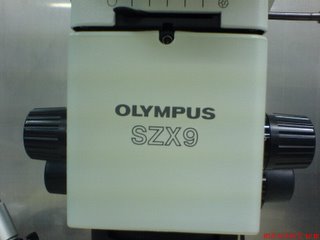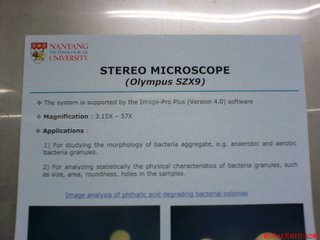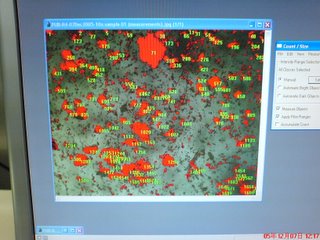 One of the tests I have to do in my analysis of sludge from the Upflow Anaerobic Sludge Blanket (UASB) reactor is to find out the size distribution & mean diameter of the sludge particles / biogranules. Basically, the bigger, the better. Why is this so? Well, there are diverse schools of though in this area & there still isn't a unified theorem about how we can explain the biogranulation process. Nevertheless, research is still on-going in this field of study & the implications could be tremendous. We could have a cheap & efficient way of treating water to make it potable & millions of people around the world will have access to drinking water. It could be a way for third world countries to improve their standard of living. No amount of money can have such a big impact on the lives of so many people.
One of the tests I have to do in my analysis of sludge from the Upflow Anaerobic Sludge Blanket (UASB) reactor is to find out the size distribution & mean diameter of the sludge particles / biogranules. Basically, the bigger, the better. Why is this so? Well, there are diverse schools of though in this area & there still isn't a unified theorem about how we can explain the biogranulation process. Nevertheless, research is still on-going in this field of study & the implications could be tremendous. We could have a cheap & efficient way of treating water to make it potable & millions of people around the world will have access to drinking water. It could be a way for third world countries to improve their standard of living. No amount of money can have such a big impact on the lives of so many people. The first step is to obtain a small sample from one of the reactor which have varying Hydraulic Retention Time (HRT - 6hrs, 12hrs, 18 hrs, 24hrs) & simply just put it into a glass dish & place it under a powerful microscope. It is connected to a normal computer & using some special software, an "photograph" is taken of the sample & we define which area of the "photograph" we want to be considered as a "particle". Using statistics, a distribution graph is tabulated & the results can be recored in an excel file. It's a simple experiment, but interpreting the results will require some background knowledge on the workings of the UASB reactor & the biogranulation process which includes the parameters by which we vary operating conditions, e.g. HRT, organic loading rate, upflow velocity, etc.
The first step is to obtain a small sample from one of the reactor which have varying Hydraulic Retention Time (HRT - 6hrs, 12hrs, 18 hrs, 24hrs) & simply just put it into a glass dish & place it under a powerful microscope. It is connected to a normal computer & using some special software, an "photograph" is taken of the sample & we define which area of the "photograph" we want to be considered as a "particle". Using statistics, a distribution graph is tabulated & the results can be recored in an excel file. It's a simple experiment, but interpreting the results will require some background knowledge on the workings of the UASB reactor & the biogranulation process which includes the parameters by which we vary operating conditions, e.g. HRT, organic loading rate, upflow velocity, etc. Ja neh!!!
Ja neh!!!
Wednesday, December 14, 2005
Particle size analyzer / image analysis
Posted by raymond chng kwang hwee at Wednesday, December 14, 2005
Labels: school
Subscribe to:
Post Comments (Atom)
0 comments:
Post a Comment